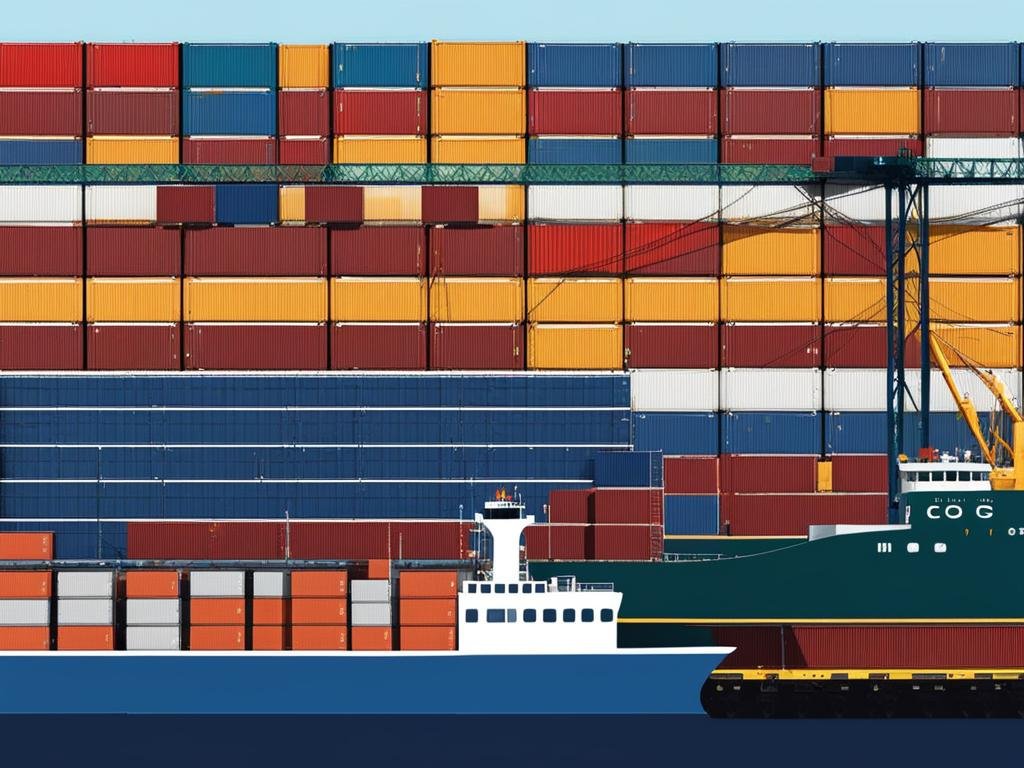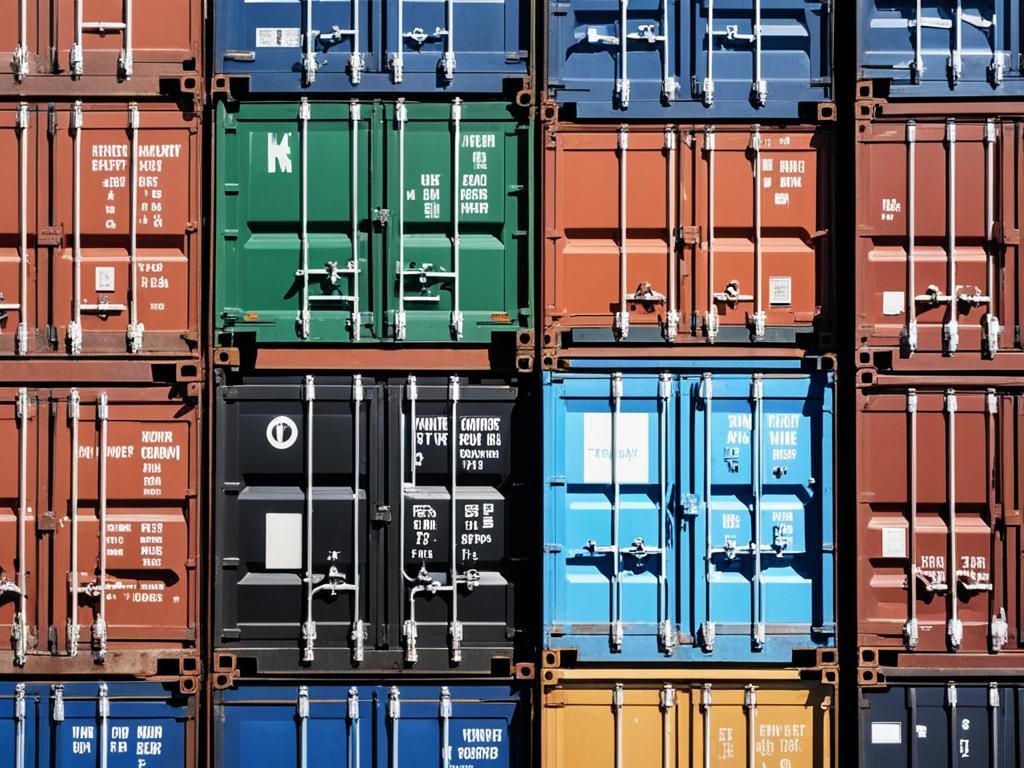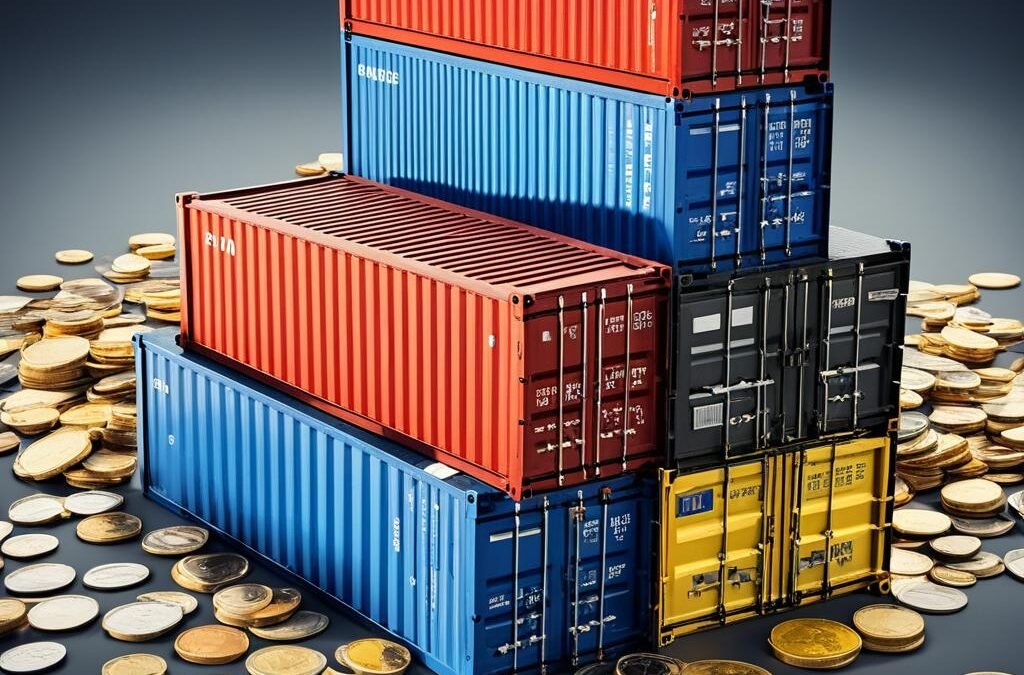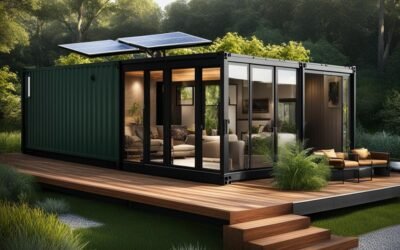Are you wondering how much shipping containers cost? Whether you’re considering buying a shipping container for personal or business use, it’s essential to understand the factors that affect their prices. From container size and condition to delivery fees and geographical location, there are several considerations to keep in mind.
Key Takeaways:
- Shipping container costs vary based on factors such as size, condition, and location.
- New 20ft standard dry containers range from $1,600 to $3,400, while used containers can be as low as $750.
- Larger containers typically offer a better cost-to-capacity ratio.
- Specialized containers, like reefers and flat racks, are more expensive due to their specialized design.
- The cost of moving a shipping container depends on distance, route, and shipping method.
New vs. Used Shipping Container Prices
When considering purchasing a shipping container, one of the primary factors to consider is whether to buy new or used. Both options have their advantages and considerations, especially when it comes to pricing. Let’s explore the key differences between new and used shipping container prices.
Price Comparison
New shipping containers, being in pristine condition, generally come with a higher price tag compared to their used counterparts. However, the cost savings associated with buying used containers can be quite significant, making them an attractive option for many buyers.
On average, a new 20ft shipping container can cost around $2,147. In contrast, a cargo-worthy used 20ft container in good condition can be purchased for approximately $1,097. The prices vary depending on factors such as demand and location.
For larger containers, such as 40ft and 40ft high cube, the price difference between new and used containers is even more apparent. On average, a cargo-worthy used 40ft container costs around $1,534, while a brand-new 40ft container can range from $3,844 and upwards.
Storage Capacity
One significant advantage of larger containers is their generous storage capacity. Although they come with a higher price tag, the extra space they provide can be invaluable for businesses and individuals with extensive storage needs. Consider the potential increase in cost per square foot when choosing between container sizes.
Factors Influencing Prices
“The prices for both new and used shipping containers will vary based on demand and location. Factors such as availability, condition, and specifications of the containers also play a significant role in determining their prices.” – Shipping Container Expert
Other factors that can influence shipping container prices include factors such as geographical location, container size, and global demand. Additionally, the condition of the container, any necessary modifications, and the cost of delivery can also impact the overall price.
To illustrate the price difference between new and used shipping containers, let’s consider the following table:
| New Container Price | Used Container Price | |
|---|---|---|
| 20ft | $2,147 | $1,097 |
| 40ft | $3,844 | $1,534 |
As evident from the table and the data provided, opting for a used shipping container can save you a substantial amount of money. However, it’s essential to carefully evaluate your needs and consider factors such as the container’s condition, your location, and the specific requirements of your storage or shipping project.
Next, we will explore the costs associated with specialized containers, providing insights into the price ranges for reefers, flat racks, and open top containers.
Costs of Specialized Containers

Specialized containers, such as reefers, flat racks, and open tops, come with unique designs, construction, and features, which contribute to their higher prices compared to standard containers. These specialized containers are tailored to specific transportation needs, ensuring the safe and efficient handling of specific types of cargo.
On average, the cost of specialized containers is as follows:
| Container Type | Average Price |
|---|---|
| Reefer (40ft) | $6,129 |
| Flat Rack | $3,462 |
| Open Top | $4,090 |
These average prices are subject to variation based on factors such as location and demand. Other specialized containers that are available for purchase include hard-top, pallet-wide, side-door, double-door, 10ft, and 53ft high cube containers, which can be found in various locations globally.
Reefers: Temperature-Controlled Containers
Reefers, also known as refrigerated containers, are specifically designed for temperature-sensitive cargo, ensuring that items such as food, pharmaceuticals, and chemicals maintain their required temperature throughout the journey. These containers are equipped with advanced cooling systems and insulation to prevent spoilage or damage to the cargo.
Flat Racks: Versatile Cargo Handling
Flat racks are ideal for oversized or irregularly shaped cargo that cannot fit into standard containers. They feature collapsible sides and end walls, making them highly flexible for accommodating cargo of different dimensions. This versatility makes flat racks suitable for transporting heavy machinery, vehicles, and construction materials.
Open Tops: Easy Top Loading
Open top containers are specifically designed to facilitate top-loading of cargo that exceeds the height of standard containers. The absence of a solid roof provides easy access for crane loading, making them ideal for transporting bulk goods, large pieces of equipment, and project cargo that require top-loading capabilities.
Factors Affecting Shipping Container Costs

When it comes to shipping container costs, several factors come into play. These factors can significantly influence the overall price of a container and should be considered when making a purchase. Let’s take a closer look at some of these key factors:
Container Size
The size of the container is a crucial factor in determining its cost. Generally, larger containers tend to be more expensive than smaller ones. This is because larger containers offer more storage capacity and are in higher demand.
Container Condition
The condition of the container also plays a role in its cost. New containers are typically priced higher than used containers due to their pristine condition and value. Used containers, on the other hand, can be significantly more affordable options for buyers.
Delivery Fees
Delivery fees can have a substantial impact on the overall cost of shipping containers. Factors such as the distance of delivery, the number of containers being shipped, and the delivery timeframe can all contribute to the final price.
Geographical Location
The geographical location where the container is being purchased can influence its cost. Container prices can vary based on factors such as supply and demand, the price of steel in that region, and the overall economic situation of the area.
Global Events
Global events, such as the current surplus of containers or inflation, can also affect shipping container costs. These events may result in fluctuations in container prices, making it important to stay informed about the latest market trends.
Considering these factors is essential for buyers who want to make an informed decision when purchasing a shipping container. Taking into account the size, condition, delivery fees, location, and global events can help ensure that buyers get the most value for their investment.
Image:
Cost to Move a Shipping Container

Moving a shipping container involves various costs beyond international transportation fees. To estimate the cost to move a container accurately, it’s important to consider several factors that impact the overall cost. These factors include:
- Distance: The distance between the origin and destination plays a significant role in determining the cost of shipping container transportation.
- Route: The specific route taken by the shipping container affects the cost, as certain routes may have higher fees or additional logistical challenges.
- Container Size and Weight: The size and weight of the container are crucial factors in determining transportation costs. Larger and heavier containers may incur higher fees.
- Shipping Method: The chosen shipping method, such as ocean freight or trucking, will have different cost structures and considerations.
- Cargo Type: The nature of the cargo being transported can impact the cost. Items that require special handling or temperature control may have additional fees.
- Shipping Line Charges: Shipping lines may have their own charges for transporting containers, which should be factored into the overall cost.
For example, ocean freight rates for a 40ft container can range from $371 to $1,609, depending on the specific route and other factors. In the USA, trucking freight rates average around $2.11 per mile.
To accurately estimate the cost to move a shipping container, it’s important to stay informed about current freight rates and shipping routes. By considering these factors and seeking accurate quotes from shipping providers, you can plan and budget for the cost of transporting your container effectively.
Get an Accurate Freight Quote
“Obtaining accurate freight quotes from shipping providers ensures that you have a clear understanding of the costs involved in moving your shipping container.”
When assessing the cost to move a shipping container, consider the unique aspects of your shipment, such as its size, weight, and destination. By obtaining multiple quotes from reputable shipping providers and comparing their rates, you can make an informed decision that aligns with your budget and shipping needs.
Why Buy Used Shipping Containers

When it comes to purchasing shipping containers, opting for used containers provides numerous benefits and cost savings. Not only are used containers more affordable than new ones, with prices starting at under $1,000, but they also offer several advantages that make them an attractive choice in the market.
One of the primary advantages of buying used shipping containers is their availability. With a surplus of containers worldwide, used options are readily accessible, allowing you to find the right container for your needs more easily.
Despite being pre-owned, used containers still boast excellent durability and strength. They are designed to withstand harsh weather conditions and rough handling, ensuring that your cargo remains safe and secure during transportation.
Furthermore, buying used shipping containers is an environmentally friendly choice. By repurposing and recycling these containers, you contribute to sustainable practices and reduce material waste.
Additionally, the demand for used containers is on the rise as more alternative uses are discovered. Used shipping containers are now being transformed into innovative structures such as homes, offices, and even art installations. This versatility adds to their appeal and increases their value.
In summary, the benefits of buying used shipping containers include:
- Cost savings compared to new containers
- Wide availability due to surplus
- Strong and durable construction
- Environmentally friendly choice
- Versatility for alternative uses
By considering the advantages of used containers and their cost savings, you can make a smart and economical choice when purchasing shipping containers.
The Costs of Shipping Containers
When it comes to purchasing shipping containers, there are several factors that determine their costs. These factors include container size, build material, age, paint job, and modifications. Let’s take a closer look at each of these factors:
Container Size
The size of the container plays a significant role in determining its price. Generally, larger containers are more expensive than smaller ones due to the increased storage capacity they offer. So, if you require a larger storage space, you can expect to pay a higher price.
Build Material
The build material of a shipping container also affects its cost. Containers made with durable materials like Corten steel tend to be more expensive. However, the higher price tag is justified by the longevity and sturdiness that these containers offer. Investing in containers constructed with high-quality materials can ensure that your cargo stays safe during transportation.
Age
The age of a shipping container can have an impact on its price. New containers and those that have only been used for a single trip are generally more expensive. This is because they are in better condition and offer a longer lifespan compared to older containers. However, if you’re looking for a more budget-friendly option, used containers can still provide cost savings while maintaining adequate quality.
Paint Job
The original paint job of a shipping container can also influence its price. A container with a fresh coat of paint may have a higher price due to the added aesthetic appeal and protective layer it provides. However, if the appearance is not a significant concern for you, opting for a container without a fresh paint job can help reduce costs.
Modifications
Modifications made to a shipping container can impact its price. Containers that have been modified with added features or customizations may come with a higher price tag. These modifications could include doors, windows, insulation, electrical installations, or extra security measures. Consider your specific needs before deciding on the level of modification required for your container.
By factoring in container size, build material, age, paint job, and modifications, you can better understand the costs associated with shipping containers. This knowledge will help you make an informed decision when purchasing a container that fits your requirements and budget.
Conclusion
In conclusion, when it comes to shipping container costs, there are a few key factors to consider. Container size, condition, location, and demand all play a role in determining the price. New containers tend to be more expensive, but opting for used containers can offer significant cost savings without compromising on durability.
Additionally, it’s important to take into account the impact of delivery fees, geographical location, and global events, as these can influence shipping container costs. Specialized containers, with their unique designs and features, generally come at a higher price point.
When making a purchase, it is crucial to carefully evaluate your specific needs and budget. By considering all of these factors, you can make an informed decision and select a shipping container that meets your requirements. Whether you choose a new or used container, ensuring you find the right balance between quality and cost is key.
In summary, understanding the various elements that affect shipping container costs empowers you to make a smart investment. By taking into account factors such as size, condition, location, and demand, you can find a container that suits your budget while still meeting your needs. Remember to consider the costs associated with specialized containers and be mindful of delivery fees and global events. With careful consideration, you can secure a shipping container that provides both value and reliability.
FAQ
What is the average cost of shipping containers?
On average, new 20ft containers cost ,147, while cargo-worthy used 20ft containers cost













